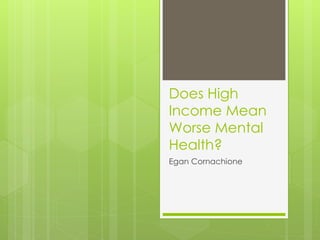
Does High Income Mean Worse Mental Health
- 1. Does High Income Mean Worse Mental Health? Egan Cornachione
- 2. Thank You!! Thank you all for being here I hope you all enjoy the presentation!
- 3. Outline Introduction to mental illnesses The link between income and mental illness What this study attempts to find Data and Model What I find
- 4. Introduction What is mental illness? What causes it? Affects 18.6% of adults age 18+ (NSDUH 2012) Rate is increasing What has been contributing to this?
- 5. Where does income fit in? Fundamental economics: growth is good Easterlin paradox (Easterlin 1974) higher incomes = happier people ↑ national income ≠ ↑ national happiness Kahneman and Deaton (2010) Emotional well-being peak: $75,000
- 6. What do we know about the link between income and mental health? Link between social inequality and mental disorders (Fryers et al 2003) Education, income, and unemployment Low income →greater mental distress: McMillan et al (2010) incomes<$17,000 Caron and Liu (2010): Living below 50% of median income
- 7. What remains to be seen? Causal effect not proven Effect of high income on mental health? High income job=high stress job Above $75,000, well-being does not improve Does the nature of high income earning lead to a higher prevalence of mental illness?
- 8. Data Health Reform Monitoring Survey, Second Quarter of 2014 Survey of 7,701 American adults aged 18-64 Responses on income, mental and physical health, and household demographics Income is divided into 19 categories: ranging from less than $5,000 to greater than $175,000.
- 9. Measures of Mental Illness Two measures: “Reported a mental or behavioral health condition” Number of days in the past 30 days with bad mental health Days w/stress, depression, emotional problems Two levels of severity: 1) any number of days with mental issues 2) a week’s worth of days (7+) with mental issues
- 10. Descriptive Statistics Income Group % of total Less than $5k 3.01% $5k-$7.5k 1.43% $7.5k-$10k 1.61% $10k-$12.5k 2.80% $12.5k-$15k 2.18% $15k-$20k 3.51% $20k-$25k 4.44% $25k-$30k 4.54% $30k-$35k 4.69% $35k-$40k 5.01% $40k-$50k 7.75% $50k-$60k 8.66% $60k-$75k 9.91% $75k-$85k 7.53% $85k-$100k 7.31% $100k-$125k 11.21% $125k-$150k 5.56% $150k-$175k 3.48% More than $175k 5.36% Mental Health Diagnosis % of population sermhcondition 15.73% mhcondition 37.87% mentalhealth 23.89% Variable % of population white 71.90% male 48.10% married 55.41% unemployed 32.83% poor_phys_health 10.88% insured 89.65% college 39.67% metro 85.61% age 45.5 Household_size 2.8
- 11. Descriptive Statistics Comparing Mental Health of Rich (Income greater than $75,000) and Poor (Income less than $25,000) Variable Rich: Poor: Obs 3115 1462 mhcondition 30.50% 49.38% sermhcondition 9.95% 25.99% mentalhealth 18.97% 33.17%
- 12. Model Independent Variable: income Dependent Variable: mental illness Controls: race, gender, age, education marital status, household size, employment status physical health, insurance type of city (metro area or not)
- 15. Results mentalhealth Coef. Std. Err. t P>t [95% Conf. Interval] rich*** -3.77% 1.10% -3.44 0.001 -5.91% -1.62% poor*** 5.29% 1.47% 3.59 0 2.40% 8.17% white*** 5.54% 1.08% 5.11 0 3.42% 7.67% male*** -5.36% 0.95% -5.62 0 -7.23% -3.49% married*** -5.29% 1.12% -4.71 0 -7.49% -3.09% unemployed*** 7.73% 1.11% 6.98 0 5.56% 9.90% poor_phys_health*** 19.46% 1.77% 10.98 0 15.98% 22.93% insured*** 9.95% 1.52% 6.57 0 6.98% 12.93% education 0.20% 0.27% 0.74 0.457 -0.33% 0.72% metro -0.79% 1.40% -0.56 0.574 -3.53% 1.96% age 0.05% 0.04% 1.29 0.199 -0.03% 0.13% household _size* -0.70% 0.37% -1.89 0.059 -1.42% 0.03% _cons 0.104696 0.040587 2.58 0.01 2.51% 18.43%
- 16. Results mhcondition Coef. Std. Err. t P>t [95% Conf. Interval] Less than $5k** 9.65% 3.72% 2.59 0.01 2.35% 16.94% $5k-$7.5k*** 8.77% 5.05% 1.73 0.083 -1.14% 18.68% $7.5k-$10k 5.67% 4.70% 1.2 0.228 -3.56% 14.89% $10k-$12.5k*** 11.78% 3.91% 3.02 0.003 4.13% 19.44% $12.5k-$15k 1.95% 4.21% 0.46 0.643 -6.31% 10.21% $15k-$20k*** 10.20% 3.42% 2.98 0.003 3.50% 16.90% $20k-$25k 4.11% 3.17% 1.3 0.195 -2.10% 10.32% $25k-$30k 2.81% 3.15% 0.89 0.372 -3.36% 8.98% $30k-$35k** 7.44% 3.10% 2.4 0.017 1.35% 13.52% $35k-$40k 0.40% 3.01% 0.13 0.894 -5.50% 6.30% $40k-$50k -1.90% 2.71% -0.7 0.483 -7.20% 3.41% $60k-$75k -2.03% 2.49% -0.82 0.413 -6.91% 2.84% $75k-$85k -1.58% 2.67% -0.59 0.552 -6.81% 3.64% $85k-$100k** -6.87% 2.65% -2.59 0.01 -12.06% -1.68% $100k-$125k*** -8.82% 2.41% -3.67 0 -13.53% -4.10% $125k-$150k*** -11.28% 2.77% -4.07 0 -16.72% -5.85% $150k-$175k* -5.57% 3.33% -1.67 0.094 -12.10% 0.95% More than $175k*** -11.05% 2.85% -3.88 0 -16.63% -5.46%
- 17. What I Find Compared to median income group: Poor: 5.3% more likely Rich: 3.7% less likely Below median income: ↑ mental illness Above median income: ↓ mental illness Logit probability of having mental illness: $100,000-$125,000: 17.04% $15,000-$19,999: 23.92%
- 18. What to Look Out For Survey bias Income is correlated with SES variables Causality not able to be determined Cross-sectional issues Possible reverse causality
- 19. Takeaways Confirmed link between low income and mental illness Increasing income does not increase mental illness Income cutoff of $175,000: Does not include variation at very high incomes Median CEO salary is around $681,000
- 20. Implications Direct policy efforts at providing mental health resources for low income adults Poor income group is far less likely to receive care Fixing this inequity is of clear importance Has Mental Illness, Unable to Afford Mental Health Care Rich (>$75,000/yr) 10.83% Poor (<$25,000/yr) 22.68%
- 21. Questions